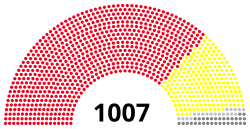Italian presidential election, 2013
|
|
||||||||||||||||||||
|---|---|---|---|---|---|---|---|---|---|---|---|---|---|---|---|---|---|---|---|---|
|
||||||||||||||||||||
|
1007 voters: 315 Senators, 4 Senators for life, 630 Deputies and 58 regional representatives 672 or 504 votes needed to win |
||||||||||||||||||||
|
||||||||||||||||||||

Composition
Napolitano 738 Rodotà 217 Others 20 Invalids, blanks 32 |
||||||||||||||||||||
|
||||||||||||||||||||
Napolitano 738 Rodotà 217 Others 20
Indirect presidential elections were held in Italy between 18 and 20 April 2013. The result was the re-election of Giorgio Napolitano, the first time a President had been elected for a second term.
Only members of Parliament and regional delegates were entitled to vote, most of these electors having been elected in the 2013 general election. As head of state of the Italian Republic, the President has a role of representation of national unity and guarantees that Italian politics comply with the Italian Constitution, in the framework of a parliamentary system.
In accordance to the Italian Constitution, the election was held in the form of a secret ballot, with the Senators, the Deputies and 58 regional representatives entitled to vote. The election was held in the Palazzo Montecitorio, home of the Chamber of Deputies, with the capacity of the building expanded for the purpose. The first three ballots required a two-thirds majority of the 1,007 voters in order to elect a president, or 672 votes. Starting from the fourth ballot, an absolute majority was required for candidates to be elected, or 504 votes. The presidential mandate lasts seven years. The term of the incumbent president, Giorgio Napolitano, was due to end on 15 May 2013.
...
Wikipedia


